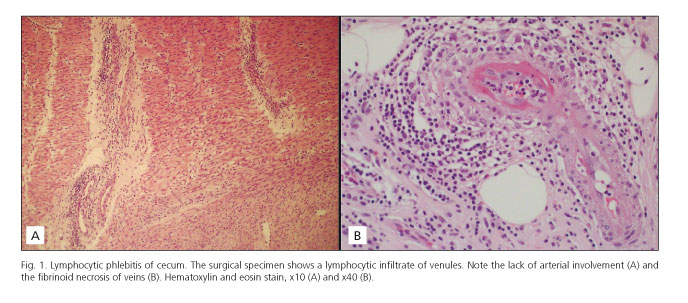Meu SciELO
Serviços Personalizados
Journal
Artigo
Indicadores
-
 Citado por SciELO
Citado por SciELO -
 Acessos
Acessos
Links relacionados
-
 Citado por Google
Citado por Google -
 Similares em
SciELO
Similares em
SciELO -
 Similares em Google
Similares em Google
Compartilhar
Revista Española de Enfermedades Digestivas
versão impressa ISSN 1130-0108
Rev. esp. enferm. dig. vol.105 no.9 Madrid Out. 2013
https://dx.doi.org/10.4321/S1130-01082013000900016
LETTERS TO THE EDITOR
Enterocolic lymphocytic phlebitis preceding the development of inflammatory bowel disease: report of a case
Flebitis linfocítica enterocólica precediendo al desarrollo de una enfermedad inflamatoria intestinal: comunicación de un caso
Key words: Enterocolic lymphocytic phlebitis. Inflammatory bowel disease.
Dear Editor,
A 37-year-old previously healthy male presented himself to the Emergency Care Department due to right lower quadrant (RLQ) abdominal pain, which had begun several hours earlier.Physical examination revealed marked abdominal tenderness with signs of peritoneal irritation and positive rebound tenderness. Laboratory tests were notable for leukocytosis (15.6 K/dL) with neutrophilia (79.4%).
Abdominal ultrasound showed a hyperechoic structure surrounded by thickened bowel wall in the RLQ, which according to the radiologist was highly suspicious for indicating acute appendicitis.
Based on the above, it was decided to proceed immediately to exploratory laparotomy with appendectomy.
At surgery a firm cecal mass was found near the ileocecal valve. The appendix was normal. Due to the high clinical probability of malignancy a right hemicolectomy was performed.
Gross examination of the surgical specimen revealed a thickened cecal wall and ulceration of cecal mucosa. Histologic examination revealed a colonic mucosa with ischemic like changes and a transmural lymphocytic infiltration of the submucosal and subserosal veins. Some veins revealed a fibrinoid necrosis of their wall (Fig. 1).
Based on these findings, a diagnosis of enterocolic lymphocytic phlebitis (ELP) was established.
The patient did well following surgery, and was asymptomatic at discharge three days later.
Three years later he was admitted to the Department of Medicine due to rectal bleeding. Colonoscopy revealed severe diffuse proctitis up to 10 cm from the anus. The histological examination revealed severe chronic active inflammatory changes consistent with inflammatory bowel disease (IBD) colitis. As a result a diagnosis of ulcerative colitis was suggested, and local therapy with hydrocortisone and mesalamine was started. The patient reported excellent symptomatic response, steroids were discontinued, and he continues to use oral mesalamine and to function well.
Discussion
ELP is a rare disorder of the gastrointestinal tract, which is characterized by inflammation of intramural mesenteric veins. Its etiology remains unknown (1). It may manifest with abdominal pain, a tumor-like mass or with GI bleeding (2). Patients with ELP generally undergo surgery, since the disease mimics several abdominal surgical emergencies.
The diagnosis is made post-operatively based on histological examination of the surgical specimen. The histologic differential diagnosis of ELP includes hypersensitivity reaction, Henoch-Schonlein Purpura, systemic lupus erythematosus, rheumatoid arthritis, Churg-Strauss syndrome and Behcet's disease. These entities can be ruled out by lack of arterial involvement, absence of neutrophils and/or eosinophils in the vascular lesion and lack of clinical evidence of systemic vasculitis (1,3,4)
Surgical resection of affected bowel is the treatment of choice (1). The disease is thought to be cured by surgery, with almost all reported cases demonstrating an uneventful course following surgical therapy (4,5).
To the best of our knowledge, a case in which IBD developed following surgical resection of symptomatic ELP has not been described. An association between ELP and IBD, as demonstrated in our case, has been suggested in a study of surgical specimens from IBD patients (6), but was not noted in clinical practice until now. More research and clinical experience is needed in order to determine the exact relationship between these two entities.
Itai Ghersin1, Edmond Sabo2 and Jesse Lachter3
1Rappaport Faculty of Medicine. Technion - Israel Institute of Technology. Haifa, Israel.
Departments of 2Pathology, and 3Gastroenterology. Rambam Health Care Campus. Haifa, Israel
References
1. Ngo N, Chang F. Enterocolic lymphocytic phlebitis: Clinicopathologic features and review of the literature. Arch Pathol Lab Med 2007;131:1130-4. [ Links ]
2. Massasso D, Henderson C, Davies D, Sugrue M, Broadfoot A, Joshua F. Enterocolic lymphocytic phlebitis: A rare mimic of appendicitis and bowel cancer. ANZ J Surg 2007;77:1031-2. [ Links ]
3. Parés D, Biondo S, Martí-Ragué J, Vidal A, Kreisler E, Jaurrieta E. Enterocolic lymphocytic phlebitis of the right colon as a cause of massive gastrointestinal bleeding. Colorectal Dis 2003;5:376-9. [ Links ]
4. Campillo-Soto A, Martín-Lorenzo JG, Torralba-Martínez JA, Lirón-Ruiz R, Mengual-Ballester M, Aguayo-Albasini JL. Idiopathic enterocolic lymphocytic phlebitis: One case report and review of the literature. Rev Esp Enferm Dig 2010;102:66-7. [ Links ]
5. Saraga E, Bouzourenne H. Enterocolic (lymphocytic) phlebitis: A rare cause of intestinal ischemic necrosis: A series of six patients and review of the literature. Am J Surg Pathol 2000;24:824-9. [ Links ]
6. Chetty R, Hafezi S, Montgomery E. An incidental enterocolic lymphocytic phlebitis pattern is seen commonly in the rectal stump of patients with diversion colitis superimposed on inflammatory bowel disease. J Clin Pathol 2009;62:464-7. [ Links ]















